
The projects that take up most of my time between donuts.
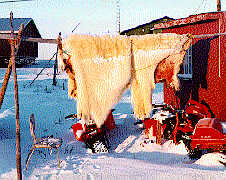
This polar bear got too close to the town of Brevig Mission!

The projects that take up most of my time between donuts.

This polar bear got too close to the town of Brevig Mission!
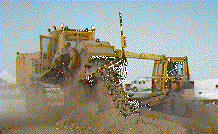 Almost all of the villages sit on top of thick (up to 1800 feet)
permafrost. In most villages, the trenches will be dug during
the winter using a rock-saw, which is a 18 foot long, 2 foot wide
chainsaw. Control of its "blade" is assisted by a survey laser,
resulting in less than an inch error.
Almost all of the villages sit on top of thick (up to 1800 feet)
permafrost. In most villages, the trenches will be dug during
the winter using a rock-saw, which is a 18 foot long, 2 foot wide
chainsaw. Control of its "blade" is assisted by a survey laser,
resulting in less than an inch error.
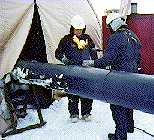 Insulated high density polyethelyne (HDPE) pipe is butt fused above ground
to be placed in the trenched later. HDPE is resistant to corrosion, and in
case of a system failure, water freezing will not damage the pipe. To help
prevent freezing the
sewer pipes are electrically heat traced, and the water distribution
lines are in loops, so the water is constantly in motion.
Insulated high density polyethelyne (HDPE) pipe is butt fused above ground
to be placed in the trenched later. HDPE is resistant to corrosion, and in
case of a system failure, water freezing will not damage the pipe. To help
prevent freezing the
sewer pipes are electrically heat traced, and the water distribution
lines are in loops, so the water is constantly in motion. The walls of the trenches dug in frozen ground are like stone. The manholes
are prefrabicated with piping and shipped to the North Slope. Flange connections
and thermo-fusion couples are used to join pipe runs in the trenches.
The walls of the trenches dug in frozen ground are like stone. The manholes
are prefrabicated with piping and shipped to the North Slope. Flange connections
and thermo-fusion couples are used to join pipe runs in the trenches.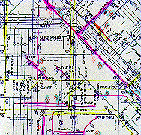 One of the largest builings in the state, the new Elmendorf Composite Medical
Facility is designed to withstand a 9.0 earthquake! When I'm not working
on the NSB water and sewer project, I reviewed/designed the seismic bracing on the
process, heating, medical, drainage, and utility piping in the hospital for
Pan-American Engineering and Botting / Poole & Kent Mechanical Contractors.
That's a whole lot of pipes.
One of the largest builings in the state, the new Elmendorf Composite Medical
Facility is designed to withstand a 9.0 earthquake! When I'm not working
on the NSB water and sewer project, I reviewed/designed the seismic bracing on the
process, heating, medical, drainage, and utility piping in the hospital for
Pan-American Engineering and Botting / Poole & Kent Mechanical Contractors.
That's a whole lot of pipes.
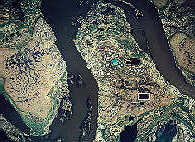 At Montgomery Watson, we just completed an upgrade to the sewage treatment systems for East and West Nunapitchuk.
The systems consist of a long term detention lagoon, where during one year of detention,
primary and secondary treatment occurs through settling and anaerobic digestion. Then in the
fall of every year, the surrounding wetlands are used to perform tertiary treatment by discharging
the lagoon effluent through a 400 ft long HDPE manifold. The effluent will be as good as that from a
mechanical lagoon, with a very low cost to operate.
At Montgomery Watson, we just completed an upgrade to the sewage treatment systems for East and West Nunapitchuk.
The systems consist of a long term detention lagoon, where during one year of detention,
primary and secondary treatment occurs through settling and anaerobic digestion. Then in the
fall of every year, the surrounding wetlands are used to perform tertiary treatment by discharging
the lagoon effluent through a 400 ft long HDPE manifold. The effluent will be as good as that from a
mechanical lagoon, with a very low cost to operate.
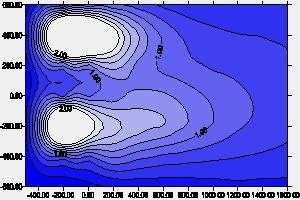 In order to determine whether a liner was necessary for a proposed landfill, we used a three dimensional
advection/dispersion model to simulate the tranport of contaminates through the
aquifer below the landfill. A visual basic engine using Excel calculated the contaminant
concentrations from the staggered use of 8 landfill cells over a ~30 year period. The model
also accounted for the uncertainty inherent in some parameters through a sensitivity analysis.
In order to determine whether a liner was necessary for a proposed landfill, we used a three dimensional
advection/dispersion model to simulate the tranport of contaminates through the
aquifer below the landfill. A visual basic engine using Excel calculated the contaminant
concentrations from the staggered use of 8 landfill cells over a ~30 year period. The model
also accounted for the uncertainty inherent in some parameters through a sensitivity analysis.